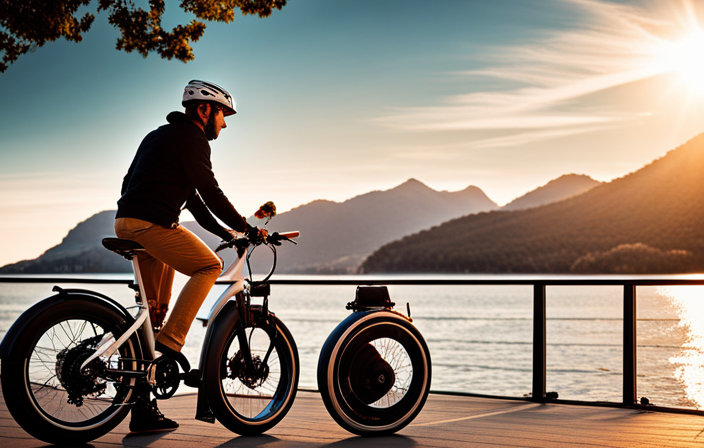Electric bikes have revolutionized the way we commute and explore our surroundings. As a passionate cyclist, I have always been curious about the inner workings of these innovative machines.
In this article, I will delve into the intricacies of electric bikes, breaking down their components, explaining their different types, and highlighting the numerous advantages they offer.
We will also explore the concept of range and battery life, address common questions, and discuss accessories and sustainability.
Join me on this journey as we uncover the truth behind electric bikes.
Key Takeaways
- Electric bikes are bicycles that are equipped with an electric motor to assist with pedaling.
- The components of an electric bike include a motor, battery, controller, and sensors.
- There are various types of electric bikes available, including city bikes, mountain bikes, and folding bikes.
- Electric bikes offer advantages such as eco-friendly transportation, health benefits, and cost savings.
How Electric Bikes Work
So, how do electric bikes actually work? Well, let me break it down for you.
Electric bikes, also known as e-bikes, are equipped with a motor and control system that provides assistance to the rider. Understanding motor power and control systems is key to comprehending how they operate.
The motor is usually located in the hub of the front or rear wheel, or sometimes in the crankshaft. It works by drawing power from a battery pack, which can be charged through a standard electrical outlet.
The control system allows the rider to adjust the level of assistance provided by the motor, commonly known as pedal assist technology. This ingenious feature enables riders to effortlessly conquer hills and cover longer distances with ease.
Now, let’s delve into the components of an electric bike.
Components of an Electric Bike
Contrary to popular belief, an e-bike is not just a regular bicycle with a secret identity. It is a sophisticated piece of machinery that combines traditional cycling with cutting-edge electric technology. The components of an electric bike are carefully designed and integrated to provide a seamless riding experience.
Here are the key components that make up an electric bike:
-
Battery: This is the powerhouse of the e-bike, storing and supplying energy to the motor.
-
Motor: The motor is responsible for assisting the rider’s pedaling, providing extra power when needed.
-
Controller: This device regulates the flow of electricity between the battery and the motor, ensuring optimal performance.
-
Display: A display unit mounted on the handlebars allows the rider to monitor important information such as speed, battery level, and assistance level.
-
Sensors: Built-in sensors detect the rider’s pedaling force and speed, enabling the motor to provide assistance accordingly.
Understanding the intricacies of these electric bike components is crucial to fully grasp the capabilities of this innovative form of transportation.
Moving on to different types of electric bikes…
Different Types of Electric Bikes
Get ready to explore the various types of e-bikes that will take you on thrilling adventures and redefine your cycling experience. There are two popular types of electric bikes: folding electric bikes and electric mountain bikes.
Folding electric bikes are designed for convenience and portability. They feature a compact frame that can be folded and easily stored in small spaces, like the trunk of a car or under a desk. These bikes are perfect for urban commuters or travelers who need a compact transportation option.
On the other hand, electric mountain bikes are built for off-road adventures. They are equipped with powerful motors and sturdy frames that can handle rough terrains and steep inclines. These bikes are perfect for adrenaline junkies who want to conquer challenging trails and explore the great outdoors.
Now that you know about the different types of electric bikes, let’s dive into the advantages of using an electric bike.
Advantages of Using an Electric Bike
Using an electric bike offers several advantages.
First and foremost, it is an eco-friendly mode of transportation. Electric bikes produce zero emissions, reducing our carbon footprint and contributing to a cleaner environment.
Additionally, riding an electric bike provides numerous health benefits, such as improved cardiovascular fitness and increased muscle strength.
Lastly, electric bikes can save you money in the long run. With lower maintenance costs and no need for gasoline, they are a cost-effective alternative to traditional vehicles.
Eco-Friendly Transportation
In today’s world, opting for an electric bike is like hitting two birds with one stone. Not only do you get to enjoy a thrilling ride, but you also contribute to a greener and more sustainable future.
Electric bikes, also known as e-bikes, offer numerous benefits that make them an eco-friendly mode of transportation. By using electricity as their primary source of power, e-bikes reduce the reliance on fossil fuels, minimizing air pollution and greenhouse gas emissions. Additionally, electric bike technology has advanced significantly, allowing for efficient energy usage and extended battery life. These bikes often come with regenerative braking systems, which convert kinetic energy into electrical energy, further increasing their efficiency.
With their eco-friendly features and cutting-edge technology, electric bikes are paving the way for a cleaner and healthier transportation future.
Moving on to the next section, let’s explore the health benefits of using electric bikes.
Health Benefits
Discover the incredible ways an e-bike can revolutionize your health and well-being. Riding an electric bike offers numerous benefits for your physical fitness. Here are five ways an electric bike can positively impact your health:
-
Low impact exercise: Electric bikes provide a gentle form of exercise that is easy on your joints, making it suitable for people of all fitness levels.
-
Cardiovascular workout: Riding an e-bike increases your heart rate, improving cardiovascular health and endurance.
-
Strength building: Pedaling an electric bike helps build leg muscles and improves overall strength.
-
Weight management: Regular e-bike riding can aid in weight loss and weight maintenance by burning calories and boosting metabolism.
-
Mental well-being: Cycling releases endorphins, reducing stress and promoting mental clarity and relaxation.
These electric bike benefits contribute to a healthier lifestyle and can improve your overall well-being.
Furthermore, the health advantages offered by e-bikes are just the beginning. They also provide significant cost savings, making them an excellent choice for both your health and your wallet.
Cost Savings
One fascinating statistic to consider is that e-bike riders can save up to 50% on commuting costs compared to traditional modes of transportation. This significant cost savings is primarily due to the low operating costs of electric bikes. Unlike cars or motorcycles, electric bikes do not require expensive gasoline or insurance.
Additionally, electric bike incentives, such as tax credits or subsidies, further reduce the upfront cost of purchasing an e-bike. When comparing electric bikes to traditional bikes, the cost savings are still evident. Electric bikes allow riders to travel longer distances without exerting excessive physical effort, making them a practical choice for commuting.
Understanding range and battery life is crucial in maximizing the cost savings of an electric bike. By carefully managing battery usage and charging, riders can fully optimize their e-bike experience and enjoy the long-term financial benefits.
Transitioning to the subsequent section about understanding range and battery life, it is essential to consider these factors for a comprehensive understanding of electric bikes.
Understanding Range and Battery Life
To better understand the range and battery life of an electric bike, you’ll need to consider factors such as the terrain you’ll be riding on and the level of assistance you’ll be using. Maximizing range is crucial for long-distance riders, and there are several factors that can affect battery life. The table below summarizes these factors:
| Factors Affecting Battery Life |
|---|
| Terrain |
| Rider Weight |
| Level of Assistance |
| Weather Conditions |
The terrain you ride on plays a significant role in determining the battery life of your electric bike. Uphill rides require more power, draining the battery faster. Additionally, factors such as rider weight and the level of assistance chosen can impact the range as well. Lastly, weather conditions, such as strong headwinds or extreme temperatures, can also affect battery performance.
Understanding these factors will help you make an informed decision when choosing the right electric bike. It’s essential to consider your specific needs and preferences to find a bike that suits you best.
Tips for Choosing the Right Electric Bike
When choosing the right electric bike, it’s important to consider your riding needs. This includes factors such as the terrain you’ll be riding on and the distance you plan to travel.
Additionally, checking the battery capacity and charging time is crucial to ensure that the bike can meet your needs.
Lastly, it’s highly recommended to test ride the bike before making a purchase to ensure that it’s comfortable and suits your riding style.
Consider Your Riding Needs
Before deciding on an electric bike, think about how your riding needs will be transformed and the exhilarating possibilities that await you.
One important aspect to consider is bike maintenance. With an electric bike, you’ll need to take into account the additional maintenance required for the motor and battery. It’s important to choose a bike that has a reliable and easily serviceable motor system, as well as a battery that can be easily replaced if needed.
Another factor to consider is choosing the right size. Electric bikes come in different frame sizes, just like regular bikes, so it’s crucial to find one that fits you properly for a comfortable and efficient ride.
Now, let’s move on to the next section about checking battery capacity and charging time.
Check Battery Capacity and Charging Time
Considering the battery capacity and charging time is crucial to ensure a seamless and uninterrupted riding experience.
When it comes to electric bikes, the battery life is a key factor that determines how far you can go on a single charge. Look for a bike with a battery capacity that suits your riding needs.
Additionally, it’s important to consider the charging infrastructure available to you. Some electric bikes come with fast charging capabilities, allowing you to recharge the battery quickly. This is especially useful if you have limited time or if you rely on your bike for daily commuting.
Having access to charging stations or a reliable home charging setup can greatly enhance the convenience of owning an electric bike.
With these factors in mind, you can confidently test ride different models and make an informed decision about which electric bike best fits your needs.
Test Ride Before Buying
When it comes to purchasing an electric bike, there are a few key factors to consider. In my previous subtopic, I discussed the importance of checking the battery capacity and charging time.
Now, let’s move on to the next step: test riding before making your final decision. This is a crucial part of the buying process as it allows you to experience firsthand the performance and comfort of the electric bike. By taking a test ride, you can evaluate the bike’s acceleration, handling, and overall ride quality. Additionally, it gives you the opportunity to ensure that you are choosing the right model that suits your specific needs and preferences. So, don’t skip this step!
Once you have completed your test ride and selected your electric bike, it’s time to move on to the next section about maintenance and care for electric bikes.
Maintenance and Care for Electric Bikes
When it comes to maintenance and care for electric bikes, there are three key points that need to be addressed.
Regular cleaning and lubrication are essential to keep the bike functioning properly and to prevent any damage or wear and tear.
Battery maintenance is crucial to ensure optimal performance and longevity of the battery.
Lastly, servicing and repairs should be done by professionals to address any issues and ensure that the bike is in top condition.
Regular Cleaning and Lubrication
To keep your electric bike running smoothly, it’s essential to regularly clean and lubricate its components, just like you would with a well-oiled machine. Regular maintenance is key to ensure optimal performance and longevity of your electric bike.
When it comes to proper cleaning, start by using a mild detergent and water to wipe down the frame, handlebars, and other visible parts. Pay extra attention to remove any dirt or debris that may have accumulated in hard-to-reach areas.
Next, focus on lubricating the moving parts such as the chain, gears, and pedals. Apply a small amount of bike-specific lubricant to these areas and ensure even distribution. This will help reduce friction and minimize wear and tear.
Now, transitioning to battery maintenance, it is equally important to take care of the power source that fuels your electric bike’s performance.
Battery Maintenance
Taking care of your electric bike’s power source is essential for maintaining optimal performance and extending its lifespan.
Proper battery maintenance includes regular charging and monitoring its lifespan. When it comes to battery charging, it’s important to follow the manufacturer’s guidelines. Overcharging or undercharging can negatively impact the battery’s performance and lifespan.
It’s recommended to charge the battery after each ride, even if it’s not fully depleted. This helps to maintain its capacity and overall health.
Additionally, it’s important to periodically check the battery’s lifespan. Most electric bike batteries have a limited lifespan and will need to be replaced after a certain number of charge cycles. By monitoring the battery’s lifespan, you can plan for its replacement and ensure your electric bike continues to perform at its best.
Now, let’s move on to the next section about servicing and repairs.
Servicing and Repairs
Maintaining and repairing your e-bike ensures its optimal performance and longevity. Regular bike servicing is essential to keep your electric bike running smoothly. It involves inspecting and adjusting various components such as brakes, gears, and tires.
Common repair issues include battery replacements, motor problems, and electrical malfunctions. If you experience any of these issues, it is best to take your e-bike to a professional for repairs. They will have the necessary expertise and tools to diagnose and fix the problem.
Remember to follow the manufacturer’s guidelines for maintenance and servicing. By keeping your e-bike in good condition, you can enjoy a safe and enjoyable riding experience.
Now, let’s move on to discussing some safety tips for riding an electric bike.
Safety Tips for Riding an Electric Bike
Ensure your safety while riding an electric bike by following these crucial tips.
- Always wear a properly fitted helmet: Protect your head from potential injuries in case of accidents or falls.
- Observe traffic rules and signals: Treat your electric bike like any other vehicle on the road. Stop at red lights, yield at intersections, and use hand signals to indicate your intentions.
- Be visible: Wear reflective clothing and equip your e-bike with lights, especially when riding at night. Make sure motorists can see you from a distance.
- Maintain your electric bike regularly: Regular maintenance, such as checking tire pressure, brakes, and electrical connections, ensures optimal performance and reduces the risk of mechanical failure while riding.
Following these safety tips for riding an electric bike will help you enjoy a smooth and secure ride. Now let’s delve into the e-bike regulations and laws to further enhance your understanding.
E-Bike Regulations and Laws
Now that we have covered safety tips for riding an electric bike, let’s dive into the important topic of e-bike regulations and laws.
It is crucial to understand the legal requirements for electric bikes to ensure a safe and compliant riding experience. E-bike safety regulations vary from country to country and even from state to state, so it is essential to familiarize yourself with the specific regulations in your area.
These regulations typically cover aspects such as maximum speed limits, age restrictions, licensing requirements, and the use of safety equipment. By adhering to these regulations, you can ensure that you are riding your electric bike within the confines of the law and promoting a safe environment for yourself and others.
Now, let’s explore the fascinating world of popular electric bike brands and models.
Popular Electric Bike Brands and Models
Discovering the world of popular e-bike brands and models will open up a whole new realm of thrilling and stylish transportation options for you. Here are three top electric bike brands known for their exceptional quality and performance:
-
Bosch: This brand is renowned for its powerful motors and long-lasting battery life. Their e-bikes offer smooth and efficient rides, making them perfect for commuting or outdoor adventures.
-
Specialized: Specialized electric bikes are known for their innovative designs and cutting-edge technology. They offer a range of models suitable for various terrains and riding styles, ensuring a comfortable and enjoyable experience.
-
Trek: Trek electric bikes combine functionality and style, making them popular among urban riders. With their sleek designs and reliable components, Trek e-bikes provide a smooth and effortless ride.
Using an electric bike has numerous benefits, including reduced carbon emissions, improved fitness, and cost savings on fuel and transportation.
Transitioning into the subsequent section about user testimonials and experiences, these popular electric bike brands have garnered positive reviews from riders across the globe.
User Testimonials and Experiences
Immerse yourself in the world of electric biking as you delve into the firsthand stories and exhilarating experiences shared by passionate riders. User satisfaction is one of the defining factors of electric bikes, and it’s easy to see why.
The benefits of electric bikes are numerous, and users are quick to highlight them. From effortless uphill climbs to extended range and reduced commuting time, electric bikes have revolutionized the way people travel. Riders express their delight in how electric bikes have made their daily commutes more enjoyable and less strenuous. Many also appreciate the environmental benefits of electric bikes, as they emit zero emissions and contribute to a cleaner and greener planet.
The user testimonials and experiences serve as a testament to the growing popularity and success of electric bikes. Now, let’s address some frequently asked questions about electric bikes.
Frequently Asked Questions about Electric Bikes
Get ready to have all your burning questions about electric bikes answered as we dive into some frequently asked questions.
-
How often should I maintain my electric bike?
Regular maintenance is crucial for the longevity and performance of your electric bike. It’s recommended to have a professional check your bike at least once a year or every 500-1,000 miles. -
What are some essential electric bike maintenance tasks?
Regularly clean and lubricate the chain, check tire pressure, inspect brake pads, and ensure all electrical connections are secure. -
How can I ensure electric bike safety?
Always wear a helmet and follow traffic laws. Be mindful of your speed and use the appropriate level of pedal assist. Regularly check lights, brakes, and reflective elements for visibility. -
Do I need special tools for electric bike maintenance?
While some tasks may require specific tools, basic bike maintenance tools such as wrenches, screwdrivers, and tire levers should be sufficient.
Now, let’s explore the exciting world of electric bike accessories and upgrades.
Electric Bike Accessories and Upgrades
Now let’s take a look at some awesome accessories and upgrades that can enhance your riding experience.
When it comes to electric bike accessories, there are plenty of options to choose from. One popular accessory is the bike rack, which allows you to carry additional gear or even another bike. Another must-have is a high-quality lock to keep your electric bike secure when you’re not riding.
Performance upgrades are also available to boost your electric bike’s capabilities. Upgrading the battery can extend your range, while a more powerful motor can provide extra speed and torque. Suspension forks and seat posts can improve your comfort on rough terrain. Additionally, adding fenders and lights can enhance your safety during night rides.
These accessories and upgrades can greatly enhance your electric bike experience and make your rides more enjoyable.
Moving on to electric bikes and sustainability…
Electric Bikes and Sustainability
Discover how incorporating an eco-friendly mode of transportation into your daily routine can contribute to a more sustainable future. Electric bikes, with their zero-emission electric motors, are a great choice for reducing pollution and minimizing our carbon footprint.
By using electric bikes instead of traditional vehicles, we can significantly reduce air pollution and greenhouse gas emissions. Additionally, electric bikes promote urban mobility by providing a convenient and efficient means of transportation in crowded cities, reducing traffic congestion and promoting a healthier lifestyle.
With their ability to cover longer distances compared to regular bicycles, electric bikes offer a viable alternative for commuting and running errands. Embracing electric bikes not only helps us contribute to a cleaner environment but also improves our overall quality of life.
Transitioning to the next section, let’s explore the future of transportation with electric bikes.
Conclusion: Embracing the Future of Transportation with Electric Bikes
Embrace the future of transportation and unlock a world of sustainable mobility with electric bikes. Every journey becomes a breath of fresh air in the pursuit of a greener tomorrow.
Electric bike technology is rapidly evolving, paving the way for a revolution in transportation. Advancements in battery technology, motor efficiency, and lightweight materials make electric bikes more powerful, efficient, and affordable.
The future of transportation lies in the hands of electric bikes. They offer a solution to the challenges of congestion, pollution, and limited parking spaces in urban areas. These eco-friendly bikes provide a convenient and sustainable alternative to traditional modes of transportation. They reduce carbon emissions and promote a healthier lifestyle.
As we embrace this future, electric bikes will undoubtedly play a crucial role in transforming the way we commute and explore our cities. They make transportation more efficient, enjoyable, and environmentally friendly.
Frequently Asked Questions
Are electric bikes allowed on bike paths and trails?
The pros of using electric bikes on bike paths and trails include increased speed and reduced effort. However, there are also cons such as limited battery life. Safety guidelines include wearing a helmet, following traffic rules, and being aware of pedestrians.
How long does it take to charge the battery of an electric bike?
It typically takes a few hours to charge the battery of an electric bike, depending on the battery capacity and charging method. The battery life can vary, ranging from 20 to 100 miles on a single charge.
Can I pedal an electric bike without using the motor?
Yes, you can pedal an electric bike without using the motor. It’s called using the pedaling technique. Pedaling not only helps conserve battery power, but also provides exercise and promotes a healthier lifestyle.
Are electric bikes suitable for long-distance rides?
Electric bikes have a long electric bike range, making them suitable for long-distance rides. They provide the benefits of reduced effort and increased speed, thanks to the motor assistance, while still allowing the option to pedal without using the motor.
What kind of maintenance is required for an electric bike?
To maintain optimal electric bike performance, regular maintenance is essential. Common electric bike problems include battery issues, motor malfunctions, and brake adjustments. Regularly inspecting and cleaning the bike, checking tire pressure, and ensuring proper chain lubrication are also important for smooth operation.
Conclusion
In conclusion, electric bikes are a revolutionary mode of transportation. They combine the convenience of a bicycle with the power of an electric motor. With their efficient design and advanced technology, electric bikes offer a sustainable and eco-friendly alternative to traditional vehicles.
One interesting statistic to note is that the global electric bike market is projected to reach a value of $38.6 billion by 2025. This indicates the growing popularity and demand for these innovative vehicles.
Embracing the future of transportation with electric bikes not only benefits individuals but also contributes to a greener and cleaner environment.
















